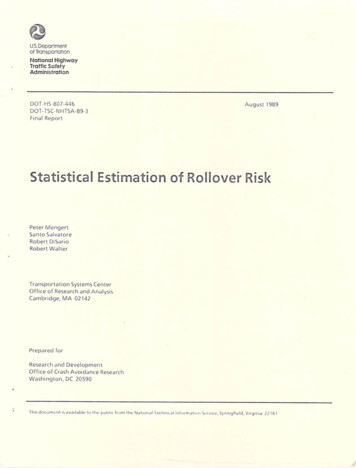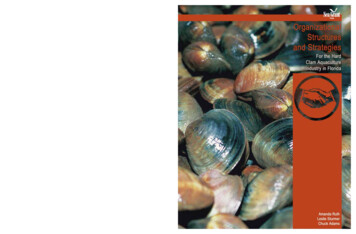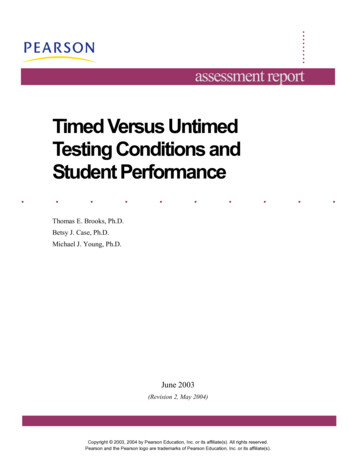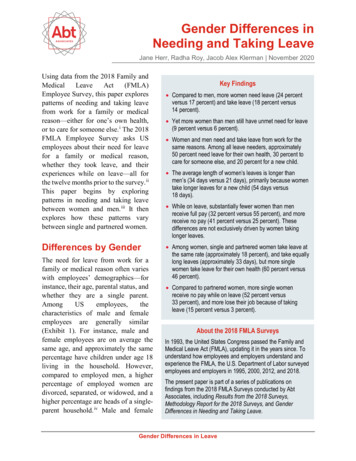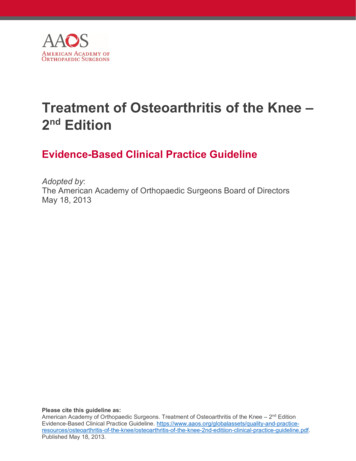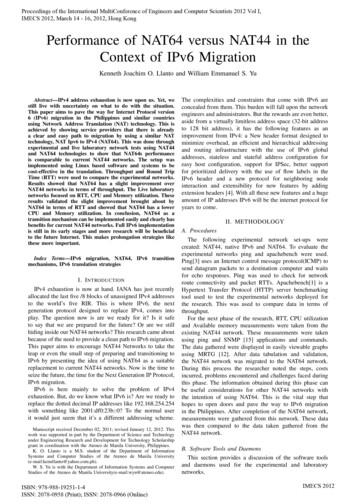
Transcription
Proceedings of the International MultiConference of Engineers and Computer Scientists 2012 Vol I,IMECS 2012, March 14 - 16, 2012, Hong KongPerformance of NAT64 versus NAT44 in theContext of IPv6 MigrationKenneth Joachim O. Llanto and William Emmanuel S. YuAbstract—IPv4 address exhaustion is now upon us. Yet, westill live with uncertainty on what to do with the situation.This paper aims to pave the way for Internet Protocol version6 (IPv6) migration in the Philippines and similar countriesusing Network Address Translation (NAT) technology. This isachieved by showing service providers that there is alreadya clear and easy path to migration by using a similar NATtechnology, NAT Ipv6 to IPv4 (NAT64). This was done throughexperimental and live laboratory network tests using NAT44and NAT64 technologies to show that NAT64s performanceis comparable to current NAT44 networks. The setup wasimplemented using Linux based software and systems to becost-effective in the translation. Throughput and Round TripTime (RTT) were used to compare the experimental networks.Results showed that NAT64 has a slight improvement overNAT44 networks in terms of throughput. The Live laboratorynetworks focused on RTT, CPU and Memory utilization. Theseresults validated the slight improvement brought about byNAT64 in terms of RTT and showed that NAT64 has a lowerCPU and Memory utilization. In conclusion, NAT64 as atransition mechanism can be implemented easily and clearly hasbenefits for current NAT44 networks. Full IPv6 implementationis still in its early stages and more research will be beneficialto the future Internet. This makes prolongation strategies likethese more important.Index Terms—IPv6 migration, NAT64, IPv6 transitionmechanisms, IPv6 translation strategiesI. I NTRODUCTIONIPv4 exhaustion is now at hand. IANA has just recentlyallocated the last five /8 blocks of unassigned IPv4 addressesto the world’s five RIR. This is where IPv6, the nextgeneration protocol designed to replace IPv4, comes intoplay. The question now is are we ready for it? Is it safeto say that we are prepared for the future? Or are we stillhiding inside our NAT44 networks? This research came aboutbecause of the need to provide a clean path to IPv6 migration.This paper aims to encourage NAT44 Networks to take theleap or even the small step of preparing and transitioning toIPv6 by presenting the idea of using NAT64 as a suitablereplacement to current NAT44 networks. Now is the time toseize the future, the time for the Next Generation IP Protocol,IPv6 migration.IPv6 is here mainly to solve the problem of IPv4exhaustion. But, do we know what IPv6 is? Are we ready toreplace the dotted decimal IP addresses like 192.168.254.254with something like 2001:df0:23b::0? To the normal userit would just seem that it’s a different addressing scheme.Manuscript received December 02, 2011; revised January 12, 2012. Thiswork was supported in part by the Department of Science and Technologyunder Engineering Research and Development for Technology Scholarshipgrant in coordination with the Ateneo de Manila University, Philippines.K. O. Llanto is a M.S. student of the Department of InformationSystems and Computer Studies of the Ateneo de Manila University(e-mail:kennllanto@yahoo.com.ph).W. S. Yu is with the Department of Information Systems and ComputerStudies of the Ateneo de Manila University(e-mail:wyu@ateneo.edu).ISBN: 978-988-19251-1-4ISSN: 2078-0958 (Print); ISSN: 2078-0966 (Online)The complexities and constraints that come with IPv6 areconcealed from them. This burden will fall upon the networkengineers and administrators. But the rewards are even better,aside from a virtually limitless address space (32-bit addressto 128 bit address), it has the following features as animprovement from IPv4: a New header format designed tominimize overhead, an efficient and hierarchical addressingand routing infrastructure with the use of IPv6 globaladdresses, stateless and stateful address configuration foreasy host configuration, support for IPSec, better supportfor prioritized delivery with the use of flow labels in theIPv6 header and a new protocol for neighboring nodeinteraction and extensibility for new features by addingextension headers [4]. With all these new features and a hugeamount of IP addresses IPv6 will be the internet protocol foryears to come.II. METHODOLOGYA. ProceduresThe following experimental network set-ups werecreated: NAT44, native IPv6 and NAT64. To evaluate theexperimental networks ping and apachebench were used.Ping[3] uses an Internet control message protocol(ICMP) tosend datagram packets to a destination computer and waitsfor echo responses. Ping was used to check for networkroute connectivity and packet RTTs. Apachebench[1] is aHypertext Transfer Protocol (HTTP) server benchmarkingtool used to test the experimental networks deployed forthe research. This was used to compare data in terms ofthroughput.For the next phase of the research, RTT, CPU utilizationand Available memory measurements were taken from theexisting NAT44 network. These measurements were takenusing ping and SNMP [15] applications and commands.The data gathered were displayed in easily viewable graphsusing MRTG [12]. After data tabulation and validation,the NAT44 network was migrated to the NAT64 network.During this process the researcher noted the steps, costsincurred, problems encountered and challenges faced duringthis phase. The information obtained during this phase canbe useful considerations for other NAT44 networks withthe intention of using NAT64. This is the vital step thathopes to open doors and pave the way to IPv6 migrationin the Philippines. After completion of the NAT64 network,measurements were gathered from this network. These datawas then compared to the data taken gathered from theNAT44 network.B. Software Tools and DaemonsThis section provides a discussion of the software toolsand daemons used for the experimental and laboratorynetworks.IMECS 2012
Proceedings of the International MultiConference of Engineers and Computer Scientists 2012 Vol I,IMECS 2012, March 14 - 16, 2012, Hong Kong1) IPtables: IPtables is the command line program usedin configuring packet filtering rules [13]. This provided themasquerading techniques for NAT44 and performed packetfiltering services for NAT44 and the IPv4 network of theNAT64 set-up.2) Berkeley Internet Name Daemon (BIND): BIND isopen source software that implements the DNS protocolsfor the Internet [2]. The purpose of BIND was to provideDNS service to the NAT44, IPv6 and NAT64 clients whenaccessing the webserver.3) Router Advertisement Daemon (RADVD): RADVDis run by Linux or Berkeley Software Distribution(BSD) systems acting as IPv6 routers. It sends RouterAdvertisement messages to a local Ethernet Local AreaNetwork (LAN) periodically and when requested by anode sending a Router Solicitation message [14]. RADVDprovided the IPv6 clients auto-configured IPv6 addresses.4) Trick Or Treat Daemon (TOTD): TOTD is a smallDomain Name System (DNS) proxy nameserver thatsupports IPv6 only hosts/networks that communicate withthe IPv4 world using some translation mechanism [7]. Thiswas used to provide IPv6 addresses for external IPv4 serversnot having IPv6 addresses so that it can accessed by the IPv6clients.5) TAYGA: TAYGA is an out-of-kernel stateless NAT64implementation for Linux that uses the TUNnnel (TUN)driver to exchange IPv4 and IPv6 packets with the kernel.It is intended to provide production-quality NAT64 servicefor networks where dedicated NAT64 hardware would beoverkill [10]. This provided the NAT64 service for the IPv6network so that access to the IPv4 webserver was madepossible from the IPv6 network. Being out of kernel relativeto IPtables that provide NAT44 functionality will probablyhave consequences on performance.6) Apachebench: Apachebench is a tool used forbenchmarking an Apache Hypertext Transfer Protocol(HTTP) server. It is designed to provide information on howthe Apache server performs. It allows simulation of varyingamounts of requests and concurrency levels [1].7) Simple Network Management Protocol (SNMP):SNMP is the standard operations and maintenance protocolfor the Internet [15]. It will be used to monitor the trafficthat passes through the interfaces of the server and othermetrics such as memory and Central Processing Unit (CPU)utilization of the router.8) Multi Router Traffic Grapher (MRTG): MRTG is a toolto monitor the traffic load on network links [12]. MRTGgenerates html pages being used to monitor the results ofSNMP and convert them to graphical information so thatdata can be easily interpreted.Fig. 1.Experimental Set-up for NAT44, native IPv6 and NAT64D. NAT44In the experimental NAT44 network, IPtables were usedto perform NAT and routing. BIND [2] was used to performthe Domain Name System (DNS) service to provide accessto the webserver. Ping was used to check for successfulconnectivity between the devices and RTT. Apachebench wasused to evaluate the performance of the network in termsof Throughput. Figure 2 shows the logical diagram of theNAT44 experimental network.Fig. 2.Logical Diagram of the NAT44 experimental networkIn this set-up, IPv4 clients were provided with non-routableIPv4 addresses inside their local networks. These clients useNAT44 as a means to connect to the IPv4 internet via thegateway’s single routable address. Figure 3 shows the flowdiagram of the NAT44 experimental network.C. Experimental NetworksFor the Experimental networks, ping/ping6 was used tosend 21 packets to the webserver to test for connectivityand RTT while the apachebench tool was used to test using1000, 2000 and 3000 requests along 10, 100, 200 and 300concurrency levels. This was chosen based on the capacityof the webserver used during the experiments. The Figure 1shows the general set-up for the experimental networks.ISBN: 978-988-19251-1-4ISSN: 2078-0958 (Print); ISSN: 2078-0966 (Online)Fig. 3.Flow Diagram of the NAT44 experimental networkE. Native IPv6Router Advertisement Daemon (RADVD) [14] was usedto provide IPv6 addresses to the clients. Since all clientsIMECS 2012
Proceedings of the International MultiConference of Engineers and Computer Scientists 2012 Vol I,IMECS 2012, March 14 - 16, 2012, Hong Kongwould fall under the same network by using RADVD, routingwas no longer needed. BIND was still used to perform theDNS service to access the webserver. Ping was used to checkfor successful connectivity between the devices and RTT.Apachebench was used to evaluate the performance of thenetwork. Figure 4 shows the logical diagram of the NativeIPv6 experimental network.Fig. 6.Fig. 4.Logical Diagram of the Native IPv6 experimental networkLogical Diagram of the IPv6 NAT64 experimental networkIn this set-up, IPv6 clients were issued routable IPv6addresses inside their local networks. These clients are ableto directly connect to IPv6 Internet using their routableaddress. They are also able to connect to the IPv4 internetusing NAT64. This set-up prepares networks for IPv6migration and allows connection to the IPv4 and IPv6internet. Figure 7 shows the flow diagram of the IPv6 NAT64experimental network.In this set-up, native IPv6 clients were issued routable IPv6addresses inside their local networks. These clients are ableto directly connect to IPv6 Internet. This is the ideal set-uponce migration to IPv6 has been completed. Figure 5 showsthe flow diagram of the native IPv6 experimental network.Fig. 7.Flow Diagram of the NAT64 experimental networkF. Laboratory NetworksFig. 5.Flow Diagram of the Native IPv6 experimental network1) NAT64: Setting-up IPv6 NAT64 requires IPtables,RADVD, TOTD, BIND, TAYGA to be used. The IPtableswere used to connect the IPv4 external network to theIP addresses to be used by TAYGA, the NAT64 daemon.RADVD was used to provide IPv6 addresses for the IPv6clients. The purpose of TOTD is to serve as a proxy serverperforming DNS64 so that IPv4 servers can be accessed bythe IPv6 network. BIND provided the actual DNS service. Totest the experimental set-up apachebench was used to accessan external IPv4 webserver and ping was also used to testRTT and connectivity between these networks. The Figure 6shows the logical diagram of the IPv6 NAT64 experimentalnetwork. This design was used to allow direct IPv6 routingon the event that the destination supports IPv6. In this case,the use of NAT64 decreases as IPv6 networks increases.ISBN: 978-988-19251-1-4ISSN: 2078-0958 (Print); ISSN: 2078-0966 (Online)For the laboratory networks, ping and the mrtg-ping probewill be used to send packets to servers outside the local areanetwork to test for connectivity and RTT. SNMP data willbe gathered to check the CPU utilization and Free Memory.MRTG will graph the SNMP and RTT results.1) NAT44 Laboratory Network: Setting-up the AteneoNAT44 network has a similar requirement for theexperimental NAT64 network and required IPtables, Ateneo’slocal DNS server and a Dynamic Host ConfigurationProtocol (DHCP) server. IPtables was used to connect theIPv4 external network to the internal IPv4 Network usingNAT44. The local DNS server provides DNS resolution forthe laboratory clients. DHCP was be used to provide dynamicIPv4 addresses to the clients. Ping was also used to testconnectivity between these networks. SNMP was used tomonitor data traffic and MRTG was used to display thegathered data. No additional configuration was done on theclients as they are all IPv4 enabled. Figure 8 shows a logicalset-up of the IPv6 NAT44 network.IMECS 2012
Proceedings of the International MultiConference of Engineers and Computer Scientists 2012 Vol I,IMECS 2012, March 14 - 16, 2012, Hong KongFig. 9.Fig. 8.Laboratory Set-up for NAT442) IPv6 NAT64: Setting-up the Ateneo IPv6 NAT64network required IPtables, RADVD, TOTD, BIND, TAYGAto be used. IPtables was used to connect the IPv4 externalnetwork to the IP addresses to be used by TAYGA,the NAT64 daemon. RADVD was used to provide IPv6addresses for the IPv6 clients. TOTD served as a proxy serverperforming DNS64 so that IPv4 servers can be accessed bythe IPv6 network. An actual DNS was used to provide theDNS service. TOTD intercepts the DNS response to add acorresponding IPv6 address if one is not present. TAYGAserved as the NAT64 daemon. The main difference this hason the experimental network is that it has actual connectionto the IPv4 Internet. In this matter, BIND can be replaced byactual DNS servers instead. DHCPv6 was also installed togive clients the IPv6 DNS servers. To test the experimentalset-up ping was used to test connectivity between thesenetworks. SNMP was used to monitor data traffic and MRTGwas used to display the gathered data. Linux clients alreadycome with IPv6 support but required installation of RecursiveDNS Server Daemon(rdnssd) [16] to be able to obtain thecorrect IPv6 DNS server. For the windows XP clients, theIPv6 protocol must first be enabled as to it is disabled bydefault. Additionally, dibbler [11] was installed to store anIPv6 DNS server to the clients. Also note that the WindowsXP clients require DNS resolution using IPv4, thus IPv4DNS must be done to allow DNS service. This would nothinder IPv6 connectivity because Windows gives priority toIPv6 DNS records over IPv4 records when both records arereturned by the DNS server. Figure 9 shows a logical set-upof the IPv6 NAT64 network.III. R ESULTSA. Experimental Testbed ResultsThis section is further subdivided into three parts: RTTresults, Throughput results and t-Test results1) RTT Results: This section shows the RTT results usingping and ping6 commands for the NAT44, native IPv6 andNAT64 experimental networks for 21 packets.a. RTT Summary : Figure 10 shows a summary of theresults of the ping command. It can be seen that theISBN: 978-988-19251-1-4ISSN: 2078-0958 (Print); ISSN: 2078-0966 (Online)Laboratory Set-up for NAT64overall performance of IPv6 is better in all aspectscompared to NAT44 and NAT64. This gives as a previewof our future networks when IPv6 migration has beencompletely implemented.Fig. 10.Summary of RTT results2) Throughput Results: This section shows the throughputresults using the apachebench tool when accessing a 173,225byte webpage. The experiments were done for 1000, 2000and 3000 requests. Each of these was done for concurrencylevels 10, 100, 200 and 300. The results for Total time, TotalBytes transferred, Successful keep alive packets, requests persecond, time per requests and transfer rates are shown inthe following subsections. Since the purpose of the paperis to evaluate the NAT64, the results discussed are all incomparison with NAT64.1) NAT64 vs. NAT44 This section shows the throughputresults when NAT64 is compared with NAT44a) Total Time Difference : The time difference betweenNAT64 and NAT44 are almost insignificant asidefrom 2 spikes of NAT64 at 1000 requests with 300concurrency and 3000 requests with 200 concurrency.It can also be noted that at 2000 requests NAT64completes all the requests in a shorter amount of timefor all concurrency levels.b) Total Bytes Transferred Difference : The differencein total bytes transferred between NAT64 and NAT44are almost insignificant. It can also be seen for NAT64at 1000 requests with 300 concurrency and 3000requests with 200 concurrency that there is a largedifference in the total bytes transferred by NAT64.IMECS 2012
Proceedings of the International MultiConference of Engineers and Computer Scientists 2012 Vol I,IMECS 2012, March 14 - 16, 2012, Hong Kongc)d)e)f)g)This is the probable reason why there are spikes atthe total time of NAT64 at these levels.Successful Keep Alive Packets Difference : Thedifference in successful keep alive packets betweenNAT64 and NAT44 are almost insignificant especiallyfor 1000 requests. It can also be seen for NAT64at 1000 requests with 300 concurrency and 3000requests having 200 concurrency that there is a largedifference in the number of successful keep alivepackets by NAT64. This is the probable explanationwhy there is a huge difference in the total bytes forNAT64 at these levels.Time per Request Difference : Aside from 1000request with concurrency level of 10, the performanceof NAT64 and NAT44 are at par with each other.Request per Second Difference : For most cases,the difference is within 1 second between NAT64and NAT44. But for almost all instances NAT64performance is better except for 1000 requests with300 concurrency level and 3000 request with 200concurrency level. This probably caused the hugedifference in the total bytes for NAT64 at these levels.Transfer Rate Difference : For almost all instancesbelow NAT64 performs better than NAT44, but thisperformance difference becomes almost insignificantat the 300 concurrency level.NAT64 vs. NAT44 Throughput Summary : The tableI below shows the summary of the throughput resultsbetween NAT64 and NAT44. It can be seen that thereis only a very small difference in the values of theiraverages.d) Time per Request Difference : For all instancesbelow, it can be seen that the performance of IPv6 isbetter compared to NAT64.e) Request per Second Difference : For all instancesin the figure below, it can be seen that the IPv6performance is a lot better than NAT64.f) Transfer Rate Difference : The IPv6 transfer rateis better for all concurrency levels and numberof requests. The value of the difference seems tostabilize close to 950 kbps at different concurrencylevels.g) NAT64 vs. IPv6 Throughput Summary : The table IIbelow shows the summary of the throughput resultsbetween NAT64 and IPv6. It can be seen that forall instances native IPv6 performs better comparedto NAT64.TABLE IINAT64 VS . NATIVE IP V 6 T HROUGHPUT S UMMARYTABLE IIIS UMMARY OF THE E XPERIMENTAL T-T EST R ESULTS FOR NAT64 VS .NAT44TABLE INAT64 VS . NAT44 T HROUGHPUT S UMMARY2) NAT64 vs. Native IPv6 This section discusses thethroughput results when IPv6 NAT64 is compared withNative IPv6a) Total Time Difference : For the time differencebetween NAT64 and IPv6, IPv6 performs better forall instances. It can also be noted that the total timedifference increases with the number of requests.b) Total Bytes Transferred Difference : The differencein total bytes transferred between NAT64 and NAT44is almost insignificant for concurrency levels 10and 100. For higher concurrency levels there arefluctuations between the total bytes transferred ofNAT64 and native IPv6.c) Successful Keep Alive Packets Difference : Thedifference in successful keep alive packets betweenNAT64 and native IPv6 is almost insignificant forconcurrency levels 10 and 100. Similar to the totalbytes transferred the number of successful keep alivepackets fluctuates for higher concurrency levels.ISBN: 978-988-19251-1-4ISSN: 2078-0958 (Print); ISSN: 2078-0966 (Online)3) Summary of t-Test Results: The Table III shows thatfor Round Trip Time, Total Time, Total Bytes Transferred,Successful Keep Alive Packets, Request per Second andTime per Request there is no significant difference for thosemetrics. Transfer Rate on the other hand showed a positivesignificant difference wherein NAT64 performed better by anaverage of 42 kb/s.B. Laboratory ResultsThis section shows the results of the live laboratory testingdone for more than 30 computers from July 4, 2011 toJuly 18, 2011 for NAT44 and August 8, 2011 to August22, 2011 for NAT64 at the F204 network laboratory in theFaura building of the Ateneo de Manila University. The datagathered were in terms of RTT, CPU Utilization and availablememory. Measurements were taken using SNMP and pingcommands and displayed using MRTG.1) RTT: This section shows the summary of the RTTresults during the two (2) 15-day periods wherein the NAT44and NAT64 networks were measured placed side-by-side.RTT was tested on two Ateneo servers, 10.2.3.8 server aserver within the WAN of the router and the 10.0.1.254, theAteneo router at the edge of the Ateneo network.IMECS 2012
Proceedings of the International MultiConference of Engineers and Computer Scientists 2012 Vol I,IMECS 2012, March 14 - 16, 2012, Hong Konga. RTT for 10.2.3.8 Graph 11 shows the RTT of pingpackets originating for our NAT gateway located atF204 during the periods of July 4 to July 18 whereNAT44 traffic was measured and August 8 to August22 where NAT64 traffic was measured. Additionally, thet-Test results for the NAT44 and NAT64 experimentswere included. Note that there was an abnormally in thebehavior of RTT during Wednesday to Thursday duringthe second week of the test, the data both from NAT44and NAT64 were removed along with the zero values toprovide a more accurate t-test result. The t-test showsthat during the time of the testing RTT is a little better forNAT64 compared to NAT44. It can also be noted that thisclosely matches the results of the experimental networks.Fig. 11.Fig. 12.NAT44 and NAT64 RTT for server 10.0.1.254 in microsecondsFig. 13.NAT44 and NAT64 CPU Utilization in percentageNAT44 and NAT64 RTT for server 10.2.3.8 in microsecondsb. RTT for 10.0.1.254 Graph 12 shows the RTT of pingpackets originating for our NAT gateway located at F204during the periods of July 4 to July 18 where NAT44traffic was measured and August 8 to August 22 whereNAT64 traffic was measured. Additionally, the t-Test theresults for the NAT44 and NAT64 experiments wereincluded. Note that there was an abnormality in thebehavior of RTT during Friday to Saturday during thesecond week of the test, the data both from NAT44and NAT64 were removed along with the zero values toprovide a more accurate t-Test result. Although NAT44performed a little better, the t-Test shows that during thetime of the testing RTT there is no significant differencebetween NAT44 and NAT64 at a p 0.75 which is belowthe 0.05 alpha. It can also be noted that this validatesthe results of the experimental networks which show verylittle discrepancy between them.2) CPU Utilization: This section shows the summaryof the CPU Utilization box plot and t-Test results duringthe two(2) 15-day periods wherein the NAT44 and NAT64networks were measured.a. CPU Utilization in percentage The box plot in Figure13 shows the CPU Utilization of the NAT44 and theNAT64 networks. It can be seen that the utilizationISBN: 978-988-19251-1-4ISSN: 2078-0958 (Print); ISSN: 2078-0966 (Online)of the router during NAT64 implementation is verylow compared to NAT44 with a median of only 1percent for NAT64 vs. about 6 percent for NAT44. Theprobable reason for this is because IPv6 packets aresimpler compared to the complex IPv4 packets and thatNAT44 performs IP address mappings to ports while theNAT64 implementation does plain IPv6 address to IPv4address mapping. Also, it could be noteworthy that onthe durations of the experiments NAT44 throughput wasgreater than that of NAT64. Despite this CPU utilizationfor NAT64 was lower.3) Available Memory: This section shows the summaryof the available memory in terms of percentage using boxplots and the t-Test results during the two (2) 15-day periodswherein the NAT44 and NAT64 networks were measured.a. Available Memory in percentage The box plot in Figure14 shows the Available memory in percentage for NAT44and the NAT64 networks and the t-Test results for the twonetworks. It can be seen that the median for NAT44 higherIMECS 2012
Proceedings of the International MultiConference of Engineers and Computer Scientists 2012 Vol I,IMECS 2012, March 14 - 16, 2012, Hong Kongcompared to NAT64. But in terms of the average, NAT64has a lower mean compared to NAT44. This highermedian for NAT44 was probably caused by the additionaldaemons installed like DHCPv6, TOTD, RADVD andTAYGA for NAT64. The higher average for NAT64 on theother hand was probably because these daemons only usemore memory during start-up and initial requests, oncethe networks have converged these daemons no longerconsume that much memory.TABLE VS UMMARY OF T-T EST R ESULTSIV. SUMMARY AND CONCLUSIONThis section discusses insights gained from the behaviorof NAT with respect to IPv6 traffic.A. SummaryFig. 14.NAT44 and NAT64 Available Memory in percentage4) Summary of Laboratory Results: This section showsthe summary of the live testing results during the two (2)15-day periods wherein the NAT44 and NAT64 networkswere measured.a. Summary of Laboratory Tests The Table IV showsthe summary of the live laboratory results of NAT64and NAT44. It can be seen that the average RTT for10.2.3.8 for NAT64 is slightly lower while for the RTTfor 10.0.1.254 NAT64 is slightly higher at that time. Interms of CPU utilization NAT64 uses less and availablememory the NAT64 performs better compared to NAT44.TABLE IVS UMMARY OF L ABORATORY T ESTSb. Summary of t-Test Results The Table V shows thesummary of the t-Test results for the live laboratorytesting for an Alpha of 0.05. The RTT for 10.2.3.8, CPUutilization and available memory in percentage and bytesall showed a significant difference between NAT64 andNAT44 while RTT for 10.01.254 showed no significantdifference between the two protocols.ISBN: 978-988-19251-1-4ISSN: 2078-0958 (Print); ISSN: 2078-0966 (Online)In terms of RTT, NAT64 and NAT44 had comparableperformance both for the experimental and laboratory results.This shows that no additional latency was caused by usingNAT64 as a transition mechanism for NAT44 networks. Interms of throughput, there was no significant difference in thebetween NAT64 and NAT44 aside from the slight advantageof NAT64 in terms of transfer rate for the experiments.CPU utilization of NAT64 fared a lot better despite of thehigher throughput during that period compared to NAT44,this is probably caused by the simpler IPv6 packet structurecompared to the IPv4 packets.For available memory, NAT44 fared well against NAT64in terms of the median, this is probably caused by theadditional processes and daemons installed in the NAT64environment. But in terms of the average available memoryNAT64 had a higher average available memory, this isprobably because the additional daemons and processes onlyrun during start-up and initializations. Ones those requestshave been completed and the network has converged NAT64stabilizes to consume lower amount of memory.Overall, we were able to validate the RTT results andthe CPU results showed that NAT64 needs less CPUresource. However, further validation needs to be done toget conclusive results on throughput for the live network testdue to the difficulty in control level.B. ConclusionIP networks can be compared using many availabletechnologies. Ping is obviously one of the most importanttool for testing connectivity and RTT. Other tools suchas apachebench and SNMP are good choices to measurethroughput and other metrics. Apachebench is a viable toolfor testing test beds mostly because of its capability tosimulate multiple concurrent devices and multiple requests.SNMP, along with MRTG is very useful in providing realtime graphs for live testing and provides the users with livestatistics that are readily available via Hypertext MarkupLanguage (HTML). Migration from NAT44 to NAT64 isan easy process as shown by the research. Planning theinterfaces and address allocation is always the first step.Setting-up a Router to provide router advertisements anddhcpv6 is the 2nd step. This is followed by the set-up ofNAT64 using TAYGA and DNS64 using TOTD. Finally,configuring the IPtables completes the tasks of migratingyour network using NAT64. For these migrations to besmooth, some considerations such as the operating systemused by clients may have certain dependencies as shownIMECS 2012
Proceedings of the International MultiConference of Engineers and Computer Scientists 2012 Vol I,IMECS 2012, March 14 - 16, 2012, Hong Kongby Windows XP and Ubuntu. The presence of a connectionto IPv6 Internet would also be helpful, must be observed.The results of the research show that NAT64 fared wellagainst NAT44 in terms of RTT for both experimental andlive networks.In terms of throughput, the experimental network showedalmost no significant diff
the IPv6 network. BIND provided the actual DNS service. To test the experimental set-up apachebench was used to access an external IPv4 webserver and ping was also used to test RTT and connectivity between these networks. The Figure 6 shows the logical diagram of the IPv6 NAT64 experimental network. This design was used to allow direct IPv6 routing

